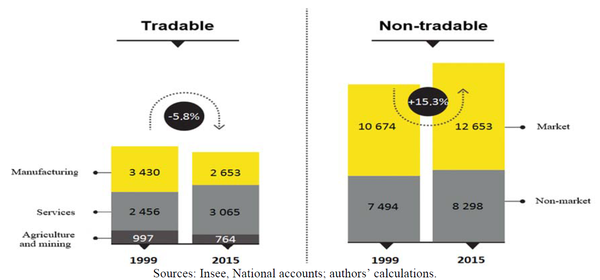Economie et Statistique / Economics and Statistics n° 503-504 - 2018 The Evolution of Tradable and Non Tradable Employment: Evidence from France
THE ARTICLE ON ONE PAGE
Key question
Technological advances in information, communication, and transportation, coupled with lower formal trade barriers, have enlarged the number of goods and services that can be traded internationally. This has generated both employment opportunities and risks. The objective of this paper is to investigate the evolution of employment in the tradable and non-tradable sectors in France over 1999-2015.
Methodology
Using census and national account data, we compute indexes of geographic concentration of production (relative to the distribution of demand) to determine if industries are tradable or non-tradable. Tradable industries may concentrate to benefit from agglomeration productivity gains whereas non-tradable industries should produce close to their consumers. The local multiplier effect of tradable jobs on non-tradable jobs is estimated using an instrumental variable method: local changes in tradable industries’ employment are instrumented by the national changes for each industry applied to the initial local share of the industry within local tradable jobs.
Main results
- In 2015, tradable employment represented about a quarter (23.6%) of total employment, and its share in total employment has decreased between 1999 and 2015.
- Non-tradable employment increased by 2.8 million, while tradable employment dropped by 400,000.
- Jobs in tradable services activities now represent almost half of tradable jobs, their growth rate has been higher than that of jobs in non-tradable services, and they are largely concentrated in metropolitan areas.
- Labor productivity and wages are higher in the tradable sector, while the skill structure is similar in the two sectors.
- The local multiplier effect of tradable jobs on non-tradable jobs is substantial: for every 100 additional jobs created in the tradable sector in an employment area in mainland France, 80 jobs were generated in the non-tradable sector within the same area.
graphiqueEmployment changes in tradable and non-tradable sectors (thousands), 1999-2015

Message
Despite increased globalization, the vast majority of jobs are not directly exposed to foreign competition. Local labor markets face different exposure to foreign competition since tradable industries tend to concentrate in certain areas. However, the local employment multiplier effect of tradable employment suggests that trade shocks spill over beyond jobs directly exposed to foreign competition.
Article on one page (pdf, 70 Ko )



